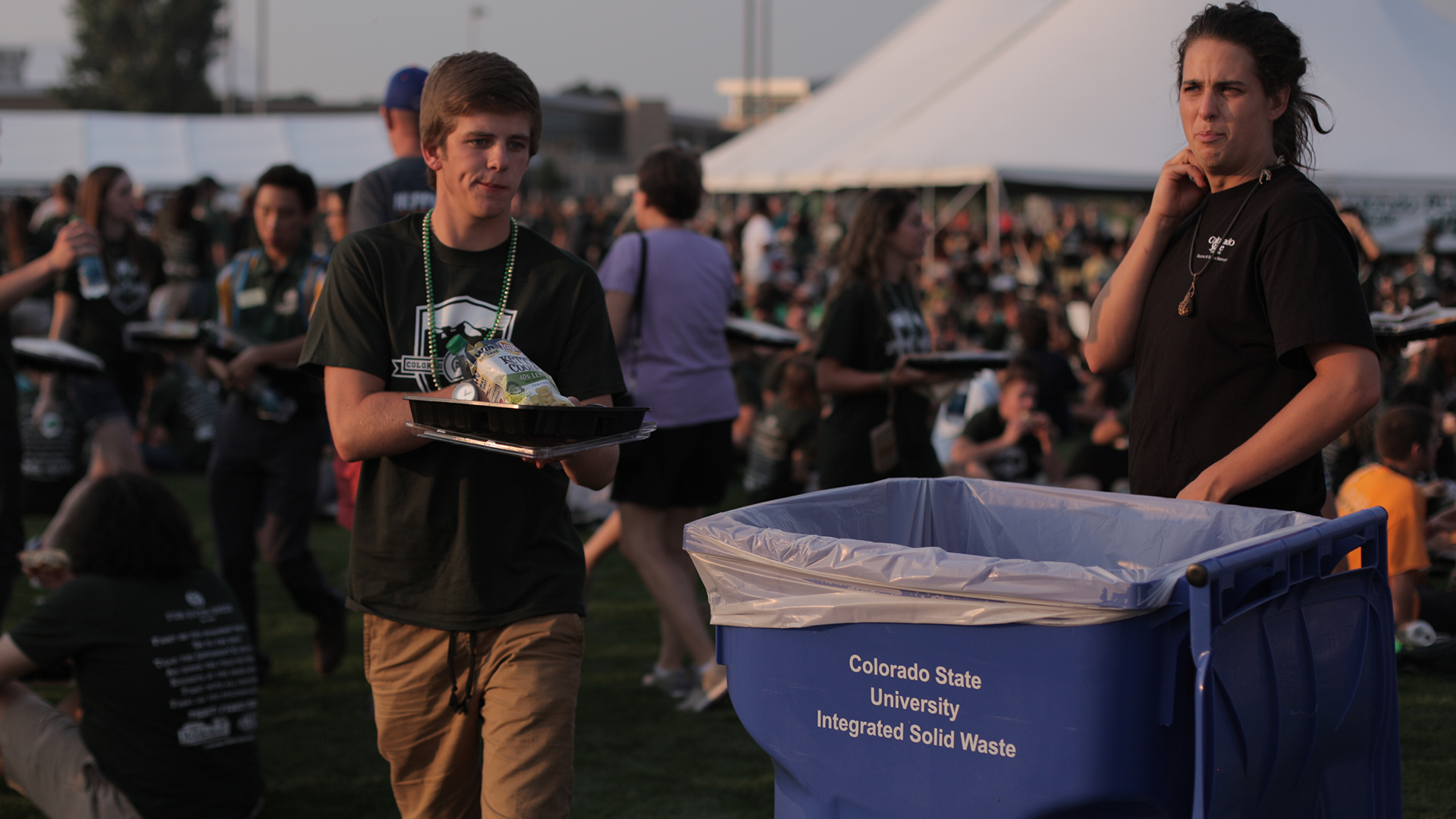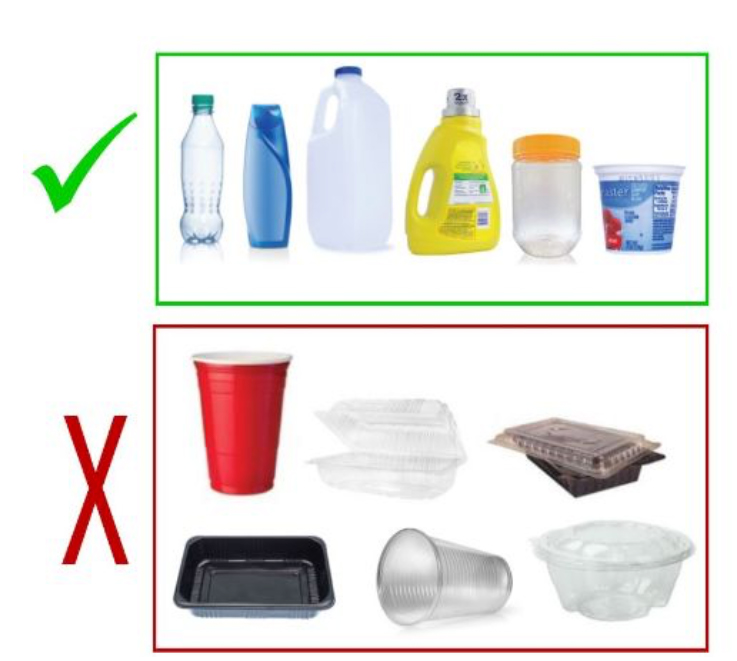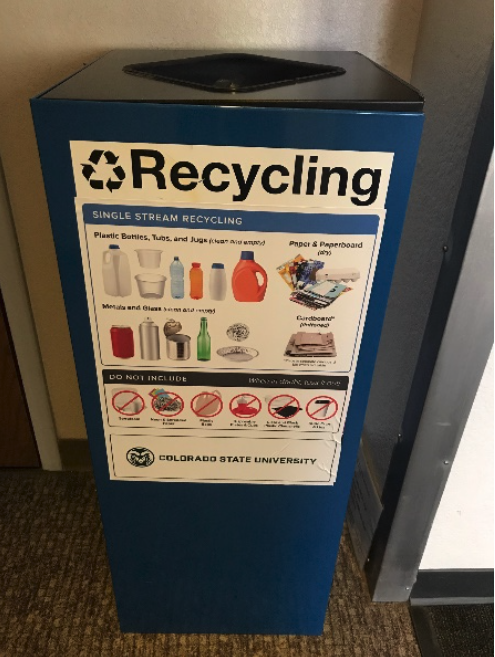
There are new recycling guidelines. Fewer plastics are recyclable: When in doubt – throw it out
Just when you think you understand how to sort your trash to help the earth – the rules change. To help mitigate confusion, Colorado State University has created new bin decals to help the campus community.
Recycling guidelines are continually updated, depending on domestic and overseas market demand. Markets have disappeared for some types of plastics, which means we now must throw low-grade plastics in the trash and relearn, once again, what can and can’t go in our recycling bins.
Recycling resources
CSU Recycling and Waste Diversion: green.colostate.edu/recycling
City of Fort Collins A-Z list of what/where to recycle: fcgov.com/recycling/atoz
“The recycling guidelines were last updated when CSU switched to single-stream recycling around 2008,” said Kirstie Tedrick, sustainability coordinator for CSU Housing & Dining Services. “This was prompted by recycling changes in Fort Collins and Larimer County. Recycling facilities were accepting single-stream recycling rather than separated streams of recyclables making it easier for consumers, including CSU.”
The recycling standard has been to look for a recycle symbol on the bottom of a container, piece of plastic, or glass. The number in the triangle determines what to do with the item: recycle it or toss it. In recent years, the single-stream system has made it relatively easy to figure out. Most items could go into one receptacle, and voila – they got recycled. Now, not so much.
Under the new system — rather than looking at the numbers stamped on plastics — focus on shapes when recycling: clean and dry bottles (water and soda), jugs (milk and laundry detergent) and tubs (yogurt and other dairy containers) are acceptable.

These types of plastics are and are not currently recyclable in Fort Collins and on the CSU campus.
Metals like cans; glass bottles and jars; and paper, cartons and cardboard all remain recyclable. Cardboard (corrugated) should be flattened and placed in separate, cardboard-only bins on campus whenever possible and only put in the single-stream recycling bin if a separate bin is not available.
With the new recycling guidelines, low-grade plastics such as berry containers, salad boxes, party cups, “clamshell” take-out containers, and black-colored food trays are no longer considered recyclable and should be thrown out. Trying to recycle such items just adds to the overall cost of processing materials, and the items must go to the landfill.
The best way to keep the low-grade plastics out of the landfill is to simply reduce the number of products we purchase in those containers. For instance, when you have a choice to purchase berries in a paperboard box or a plastic container, choose paperboard. Or, if given the choice between buying a plastic container or glass jar – choose the glass. Small changes in buying habits add up.
Recycling at CSU

To make it easier for the CSU community to keep up with the changes, new stickers are being placed on indoor and outdoor recycling bins and stations throughout campus, with images showing what is okay and not okay to recycle.
“Since the push for education is to have the cleanest recycling stream possible, we are encouraging folks to think: When in doubt, throw it out,” Tedrick said.
The effectiveness of recycling efforts on campus is measured annually through a spring Waste Audit, hosted by CSU Facilities and Housing & Dining Services’ Sustainability Team.
“We take a sampling of all our streams (recycling, compost, and landfill) from all the residence halls during a 24-hour period, and sort through the materials (all 2,000 pounds),” Tedrick said. “This event gives us a good insight into how clean the streams are, and which items are being placed mistakenly in the wrong streams. Teaching others to sort properly and cleanly helps lead the way to change. We can also suggest plastic alternatives such as metal or silicone straws, reusable cutlery and bags, and reusable bottles and mugs.”
A big push is underway to engage and educate students about the new guidelines and spread the word as much as possible. Students have a big impact on the waste stream, so modeling good behavior for them is the first step.
Recycling tips
Refer to CSU’s new Waste Sorting Guide at col.st/5P035.
Always be sure that the containers are clean and dry before recycling – this applies to all recyclable materials, not just plastics. If food or moisture are left on an item, mold may develop during the weeks it takes to get the items overseas to processing facilities, contaminating the whole lot.
Do NOT recycle motor oil, chemical, or pesticide bottles.
Whether or not a plastic item is recyclable is no longer associated with the number printed in the recycle symbol on the item (1-7). Instead, it is now dependent on the shape of the item (tubs, jugs, and bottles can be recycled).
Compost where available on campus. Use compost bins to dispose of materials such as food scraps, coffee grounds, napkins/paper towels, and products labeled “compostable” (unless a coffee cup is labeled compostable, it belongs in the trash).